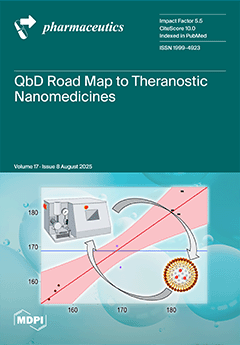Background/Objectives: Toxoplasmosis, a zoonotic disease caused by
Toxoplasma gondii, typically is asymptomatic in immunocompetent individuals but causes severe complications in immunocompromised subjects and during pregnancy. Current treatments such as pyrimethamine and sulfadiazine are effective for acute infections but cannot eliminate encysted bradyzoites
[...] Read more.
Background/Objectives: Toxoplasmosis, a zoonotic disease caused by
Toxoplasma gondii, typically is asymptomatic in immunocompetent individuals but causes severe complications in immunocompromised subjects and during pregnancy. Current treatments such as pyrimethamine and sulfadiazine are effective for acute infections but cannot eliminate encysted bradyzoites and have significant side effects. The antimicrobial killer peptide (KP) has interesting therapeutic potential, but its intracellular delivery is challenging; hyaluronate-based nanoparticles loaded with KP (KP-NPs) were evaluated to target
T. gondii-infected cells that overexpress CD44.
Methods: KP-NPs made of chitosan and hyaluronate were produced by microfluidics and were characterized for size, surface charge, encapsulation efficiency, and stability under stress conditions. After excluding their toxicity, their activity was tested in vitro against
Candida albicans and
T. gondii as free tachyzoite or in infected human foreskin fibroblasts (HFFs).
Results: KP was efficiently encapsulated in nanoparticles and protected from harsh acidic conditions at high temperature. Preliminary in vitro testing against
C. albicans showed that, at the lowest candidacidal concentration of KP (2.5 μg/mL), KP-NPs killed 90.97% of yeast cells. KP itself proved to be non-toxic for HFFs as host cells and effective against
T. gondii. Comparable results were obtained for KP-NPs and blank nanoparticles (BLK-NPs), with no observed toxicity to host cells, confirming that encapsulation did not alter peptide efficacy. The parasiticidal effect of KP alone, as well as KP-NPs at 250 µg/mL and BLK-NPs, was confirmed through tests on free
T. gondii tachyzoites. Reduction rates for the number of infected cells ranged from 66% to 90% with respect to control, while the reduction in the number of intracellular tachyzoites ranged from 66% to 80%. Interestingly, KP alone was not effective against intracellular tachyzoite, while KP-NPs maintained an efficacy comparable to the extracellular model, suggesting that particles helped the internalization of the peptide.
Conclusions: Encapsulation of KP into hyaluronate/chitosan nanoparticles does not alter its activity and improves its efficacy against the intracellular parasite. Notably, BLK-NPs appeared to exhibit efficacy against the parasite on its own, without the presence of KP.
Full article






